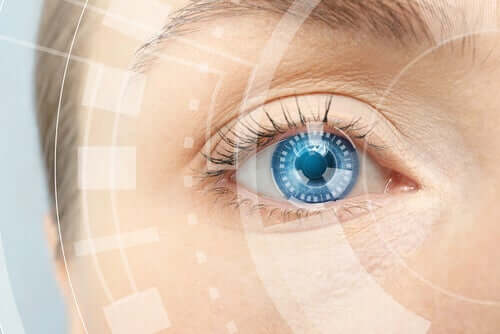What Is Lazy Eye? All You Need to Know

“Lazy eye” is a condition where there is a loss of visual acuity in one or both eyes. However, there’s not a deficiency or structural abnormality in the eyeball. The problem has another name, amblyopia, and is common in children.
Researchers estimate that lazy eye is present in 4% of children. If not treated before 8 or 9 years of age, it can become an irreversible visual defect. In fact, it’s considered to be one of the main causes of vision loss in developed countries.
However, the lazy eye doesn’t achieve 100% visual acuity, even if there’s optical treatment. In recent years, scientists found that using electronic devices, like tablets or cell phones, speed up lazy eye, and make its symptoms worse.
What is lazy eye?

Lazy eye, or amblyopia, is a disorder that leads to a decrease in visual acuity, without any abnormality in the structures of the eyes. Also, there isn’t a disease that causes the problem. In this case, there isn’t full vision, even if you get corrective treatment.
Check this out: 5 Things Your Eyes Say About Your Health
Usually, this disorder only affects one eye, but there are also many cases where it affects both eyes. There are several types of lazy eye or amblyopia. They are:
- Strabismus amblyopia. It occurs when the eyes are not perfectly aligned. This confuses the brain, which eventually stops paying attention to one of the images and ends up canceling it.
- Amblyopia due to deprivation. This happens when there’s a congenital cataract, a drooping eyelid or “ptosis” or a clouding of the cornea. All these conditions impede the correct visual development.
- Refractive amblyopia. This occurs when there’s a large refractive defect in the eyes. This causes the brain to stop sending messages to the most affected eye. Also, it’s the hardest type of lazy eye to diagnose.
Causes of lazy eye
Lazy eye is a consequence of the lack of development in the connection between the eye and the brain. What happens is that the brain learns to ignore the information coming from one of the eyes. Sometimes, over time, it ignores information from both eyes. It’s not a problem in itself, although it can be the cause or effect of eye problems.
The most common cause is strabismus. In this, the muscles fail to align the eyes properly. This causes the brain to get a different image from each eye. To fix that confusion, the brain systematically ignores one of the images.
This means that one of the eyes isn’t used. Then, the area of the brain that corresponds to it doesn’t develop. Also, it’s common for the difference in images to be because each of them has a different degree of myopia, hyperopia, or astigmatism.
In those cases, the brain also ends up prioritizing one eye over the other. Other conditions also cause vision problems that lead to lazy eye. The main ones are clouding of the lens and infantile cataracts, among others.
Other important information

The American Optometric Association recommends getting a first eye exam at 6 months old. Ideally, the second test should be at 3, then again before going to school.
You might be interested: 10 Foods to Help You Maintain Healthy Eyesight
Sometimes, doctors don’t detect lazy eye early. In fact, it’s sometimes confused with developmental or other disorders. A child with a lazy eye may have motor development delays, and may even pass for autistic, but it’s really from amblyopia.
Also, children with lazy eyes tend to read more slowly than kids with normal vision. Of course, this can cause academic, social, and even behavioral problems. Therefore, early detection is very important.
All cited sources were thoroughly reviewed by our team to ensure their quality, reliability, currency, and validity. The bibliography of this article was considered reliable and of academic or scientific accuracy.
- Moguel-Ancheita, S., & Orozco-Gómez, L. P. (2007). Disfuncionalidad neuronal y psicomotora como resultado del retraso en el tratamiento de la ambliopía. Cirugía y Cirujanos, 75(6), 481-489.
- Roselló Leyva, Annelise, Rodríguez Masó, Susana, Rojas Rondón, Irene, Linares Guerra, Marilyn, Ramos Gómez, Eduardo Ariel, & Vázquez Adan, Yanis. (2011). Defectos refractivos más frecuentes que causan baja visión. Revista Cubana de Oftalmología, 24(2), 271-278. Recuperado en 02 de noviembre de 2020, de http://scielo.sld.cu/scielo.php?script=sci_arttext&pid=S0864-21762011000200007&lng=es&tlng=pt.
This text is provided for informational purposes only and does not replace consultation with a professional. If in doubt, consult your specialist.








